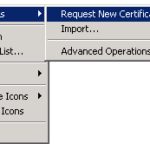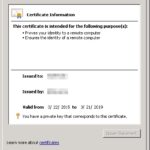Mit vSphere 6 bietet vMware eine eigene Zertifikatsstelle (vmcad) für seine Produkte an. Wer aber dennoch lieber eigene Zertifikate verwenden möchte kann dies natürlich auch weiterhin tun.
Zertifikat Request erstellen:
C:\Program Files\VMware\vCenter Server\vmcad>certificate-manager _ _ _ _ _ _ _ _ _ _ _ _ _ _ _ _ _ _ _ _ _ _ _ _ _ _ _ _ _ _ _ _ _ _ _ | | | *** Welcome to the vSphere 6.0 Certificate Manager *** | | | | -- Select Operation -- | | | | 1. Replace Machine SSL certificate with Custom Certificate | | | | 2. Replace VMCA Root certificate with Custom Signing | | Certificate and replace all Certificates | | | | 3. Replace Machine SSL certificate with VMCA Certificate | | | | 4. Regenerate a new VMCA Root Certificate and | | replace all certificates | | | | 5. Replace Solution user certificates with | | Custom Certificate | | | | 6. Replace Solution user certificates with VMCA certificates | | | | 7. Revert last performed operation by re-publishing old | | certificates | | | | 8. Reset all Certificates | |_ _ _ _ _ _ _ _ _ _ _ _ _ _ _ _ _ _ _ _ _ _ _ _ _ _ _ _ _ _ _ _ _ _ _| Note : Use Ctrl-Z and hit Enter to exit. Option[1 to 8]: 1 Please provide valid SSO password to perform certificate operations. Password: 1. Generate Certificate Signing Request(s) and Key(s) for Machine SSL certificate 2. Import custom certificate(s) and key(s) to replace existing Machine SSL certificate Option [1 or 2]: 1 Please provide a directory location to write the CSR(s) and PrivateKey(s) to: Output directory path: c:\tmp\6 2015-03-22T14:25:31.824Z Running command: ['C:\\Program Files\\VMware\\vCenter Server\\vmcad\\certool.exe', '--genkey', '--privkey', 'c:\\tmp\\6\\machine_ssl.key', '--pubkey', 'c:\\users\\admin\\appdata\\local\\temp\\2\\pubkey.pub'] 2015-03-22T14:25:32.064Z Done running command 2015-03-22T14:25:32.067Z Running command: ['C:\\Program Files\\VMware\\vCenter Server\\vmcad\\certool.exe', '--gencsrfromcert', '--privkey', 'c:\\tmp\\6\\machine_ssl.key', '--cert', 'c:\\users\\admin\\appdata\\local\\temp\\2\\vecs_crt.crt', '--csrfile', 'c:\\tmp\\6\\machine_ssl.csr'] 2015-03-22T14:25:32.116Z Done running command CSR generated at: c:\tmp\6\machine_ssl.csr
Anschließend diesen Request von seiner Zertifikatsstelle signieren und das Zertifikat im Base64 Format wieder auf dem Server zur Verfügung stellen.
Dann kann dieses jetzt importiert werden:
1. Continue to importing Custom certificate(s) and key(s) for Machine SSL certificate 2. Exit certificate-manager Option [1 or 2]: 1 Please provide valid custom certificate for Machine SSL. File : c:\tmp\6\machine_ssl.cer Please provide valid custom key for Machine SSL. File : c:\tmp\6\machine_ssl.key Please provide the signing certificate of the Machine SSL certificate File : c:\tmp\6\root-base64.cer You are going to replace Machine SSL cert using custom cert Continue operation : Option[Y/N] ? : y Status : 100% Completed [All tasks completed successfully]
Alternativ kann man auch mit Hilfe des Windos-Zertifikatsdienst ein Zertifikat anfordern, austellen lassen und exportieren:
Das Zertifikat als .pfx (mit Private Key’s) exportieren und anschließend per OpenSSL für vMware konvertieren.
Key exportieren:
openssl pkcs12 -in 123.pfx -nocerts -out key.pem -nodes Enter Import Password: MAC verified OK
Zertifikat exportieren:
openssl pkcs12 -in 123.pfx -nokeys -out cert.pem Enter Import Password: MAC verified OK
Passwort vom Key entfernen:
openssl rsa -in key.pem -out server.key writing RSA key
Die beiden Dateien (cert.pem & server.key) könnt ihr anschließend über den Certificate-Manager importieren.




Hey Constey,
Vielen Dank für die Anleitung.
Das hat mir geholfen mein Problem auf den richtigen Weg zu bringen.
Wie bist du darauf gekommen, dass die Zertifikate im BASE64 Format sein müssen ??
Gruss
Thomas
Hi Thomas,
ist mit Sicherheit auch irgendwo dokumentiert, aber ich hatte damit schon länger zu tun und vMware hat überall Base64 Zertifikate verwendet 🙂
Gruß
Cons
Hallo,
wie kann ich die Zertifikate importieren, wenn sie die Anforderung mit OpenSSL erstellt habe?
Grüße
Mathias
Danke Kollege,
genau danach hab ich gesucht 🙂
PS: Kennst mich noch?
Hallo,
wenn man ein Zertifikat mit Hilfe des Windows-Zertifikatsdiensts anfordert und über OpenSSL konvertiert, erhält man ja die beiden genannten Dateien cert.pem & server.key. Beim Importvorgang des Certificate-Managers werdn jedoch drei Dateien verlangt:
„Please provide the signing certificate of the Machine SSL certificate“
Welche Datei wird hier benötigt?
Grüße
Kevin